- It’s What We Do
- Kashmir: mystic adventure – Over the top…literally
- 25 years, 280 DRZs and only one Roy Kunda – Suzuki’s best customer?
- BMW Safari Enduro – No bull! No wait…
- Triumph Tiger Explorer 1200 – Updated, upgraded and up to the job
- WTF – Not what you think
- LEDs – Light work
- The Precious 3: Peter Payne’s XT1200Z Ténéré
- Industry player – Philth Hodgens
- HARD Kits Husky 710 – Phwoar!
- Reader’s ride – I Finke, therefore I am
- Cornered with Karen Ramsay
- Preparing for adventure with Andrea Box
- How To Ride with Miles Davis
- Checkout
- Fit Out
therefore I am
Eight mates set out to tackle the tough two: The Finke Desert Race and The Simpson.
Eight of us were heading out from the NSW east coast to the Simpson Desert, catching the Finke Desert Race on the way. We had three brand-new SWM 650s, two KTM 690s, a DR650, a DRZ plus a Land Rover support vehicle.
Winter kicked in cold and wet as we started and got worse as we went through the blue mountains.
We sought refuge in the Lithgow Woolworths carpark, tooled up with garbage bags under our jackets and headed back out into the storm. We enjoyed the beautiful countryside, greener than usual, through chattering teeth until we arrived at Dunedoo, via Mudgee, for a late lunch.
The further west we went the more sunshine we got, though the rain continued to dog us.
We called it quits for the day at Nyngan and rented a couple of cabins to dry out. We were short of our scheduled stop at Mulga Creek, 120km up the road, but night had fallen and the stop gave the Land Rover a hope of catching us.
A session at the Nyngan pub with a big feed provided a great lift.
When we got back to the cabins at about 10:00pm the Land Rover was just pulling in. After much handshaking and backslapping we heard Charles, the driver, had had a rough day with radiator dramas stopping him every 40km. We spent some time discussing the problem.
The easiest to rule out was the thermostat. We removed it and still had the problem. An air-lock was a possibility. The worst candidates were head gasket and/or a warped head.
We decided to press on to Bourke in the morning.
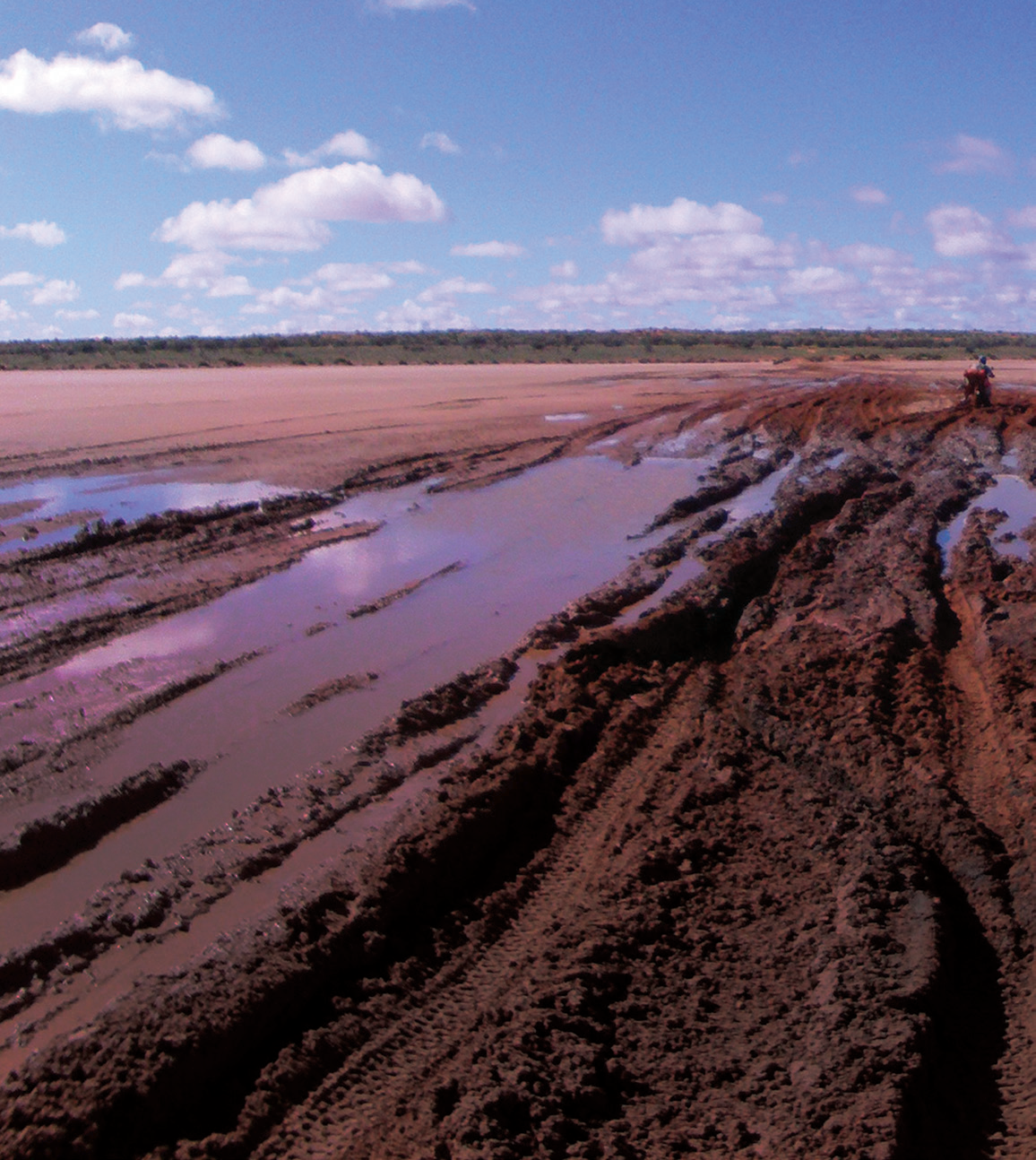
Cool
We sped past the famous Mulga Creek Hotel where we should’ve spent the first night and the Land Rover boiled religiously at the 40km and 80km mark. Then Charles had an epiphany: he parked the vehicle facing up the steep side of the road.
Like burping a baby the result was miraculous as a big airlock cleared.
The radiator then took on an extra few litres of fluid and the Land Rover made it through to Bourke without further boiling. Problem solved! Eureka!
But our tormentors weren’t finished with us. We filled up and were about to head to Cunnamulla when someone asked, “What’s that fluid pouring out under the Land Rover?”
The Omega Protocol
The call was made to enact the Omega Protocol.
This meant disgorging the contents of the Land Rover and then each of us picking the essential components to take with us. Matt, for instance, had a predilection for rum-and-raisin chocolate, so filled his boots with it. Jack thought a 500-watt RMS boombox (with apparently only one song – AC/DC’s Highway To Hell) was absolutely vital to the success of the mission. An axe and a 1.5-litre bottle of ethanol also made their way into the kit.
When we were finished there was a neat pile of unessential items to put back in the Land Rover…things like packets of assorted nuts and bolts, wire, a chain breaker, spare chain links, tubes, sprockets, a 12mm spanner, food and that kind of thing.
We headed off to Cunnamulla, loaded to the gunwales with useless junk. Charles spent a few days in Bourke and replaced the head gasket. That got him as far as Tennant Creek where he replaced the head and finally fixed the problem.
We never saw Charles again on the trip as he couldn’t cut back to join us due to road closures. He went home via Port Augusta and Wilcannia and had an adventure of his own.
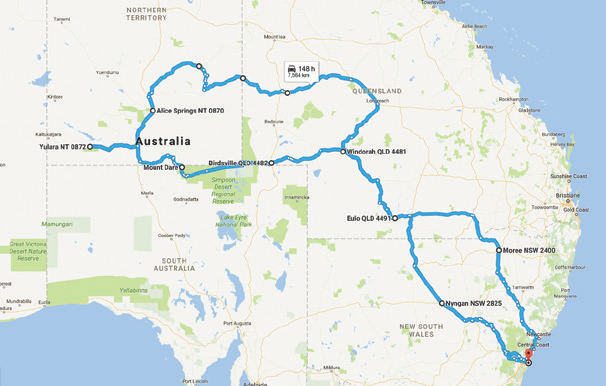
Cunnamulla and Eulo
We were in Queensland at last, but so was the Flying Doctor Rally which consisted of about one million cars, all lined up for petrol at the only bowser for a squillion kilometres. Even after queue jumping it took nearly 45 minutes to fuel up.
By then it was dark so we were looking for a place to stay. There was nothing left in Cunna-bloody-mulla and we were advised to head on to Eulo, about 70km and 500 kangaroos west.
Eulo coughed up a great, friendly pub with dry camping spots out the back.
The publican, Jacko, proved a font of out-back knowledge and helped us plan the path to the NT border. Our exact route remained fluid (in two senses of the word) as roads opened and closed due to the rain moving around what is normally very dry country.
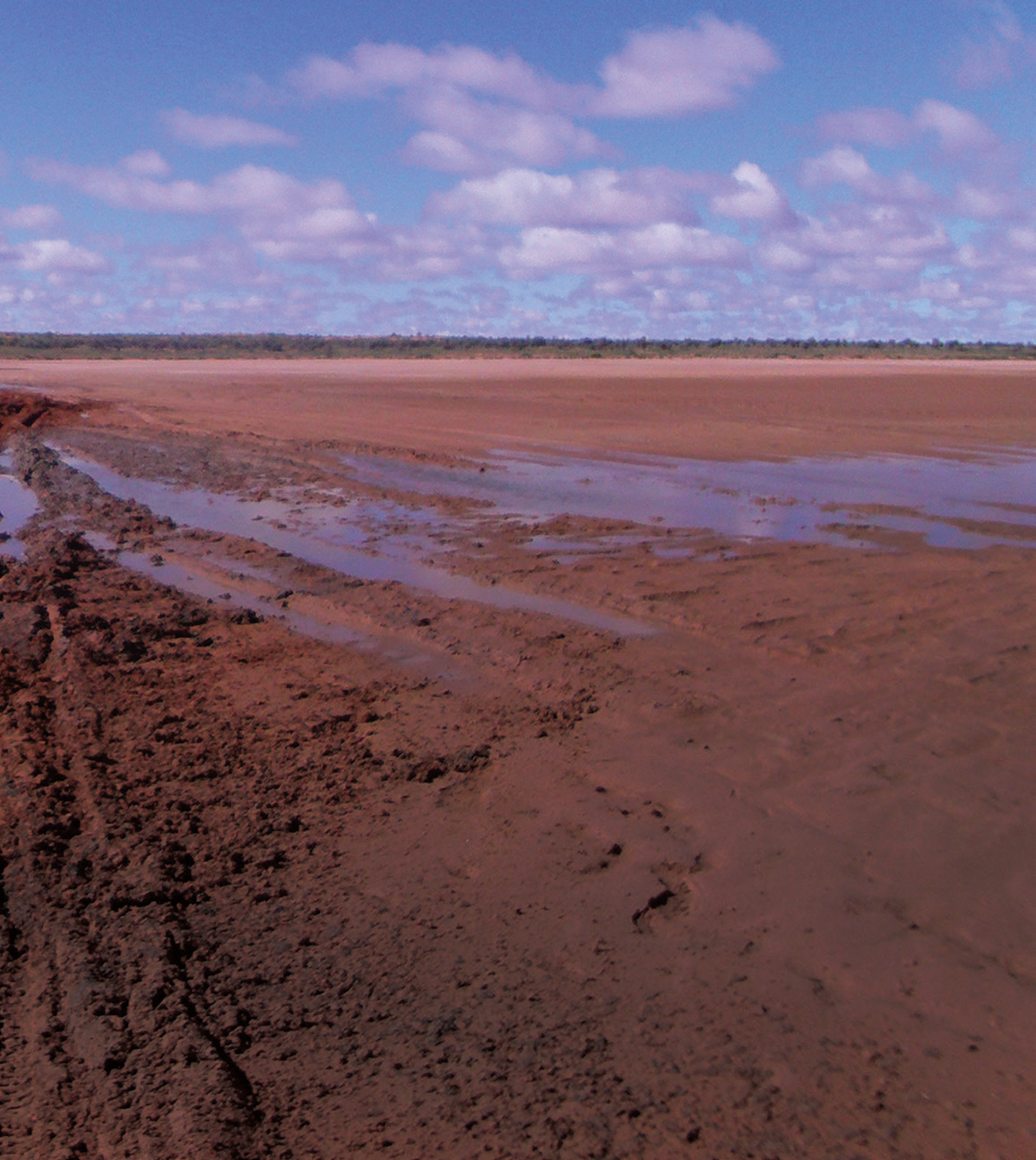 The wet weather and heavy traffic had turned most of the track into a kind of dark, desert highway
The wet weather and heavy traffic had turned most of the track into a kind of dark, desert highway
Toompine, Quilpie and Windorah
On the long bitumen thrash to Windorah we were accompanied by our car-rally mates. It cost us an extra hour at Quilpie and nearly two hours at Windorah. They were onto us now and had developed a tactic to stop us queue jumping. One tactic was weapons-grade friendly chat, “Where are you from? And where are you heading?” repeated by each of them. The other tactic was a 1960s Buick with a 160-litre secondary tank fuelled through a four-millimetre hose three drops at a time. When we finally left Windorah it was getting dark – again. Having vowed at the start of the trip never to travel in the dark we were three out of three.
I love all the outback country. The vast plains of never-ending scrub, the mulga, the silver gidgee and their Acacia cousins that seem to thrive on sand and air are all fabulous.
But as you leave Windorah the country changes dramatically to a Martian-like landscape and every-thing becomes red earth and sun-varnished rocks with craggy low hills shimmering on the horizon.
 The SWMs were a pleasure to ride on any surface and could handle the toughest stuff with ease.
The SWMs were a pleasure to ride on any surface and could handle the toughest stuff with ease.
Jack off
From Windorah we headed up through the Channel Country in the Diamantina National Park. There was a lot of dirt road and track at last, but no petrol or drinking water for 650km. Naturally we forgot to get water in Windorah and were looking forward to a thirsty few days when, like a mirage, we came to a freshly made rest stop about 80km out of Windorah that had a rainwater tank.
On dark we camped at the side of the road and helped ourself to a magnificent campfire made with heavy lumps of craggy old mulga which was there in abundance.
Having watched a lot of war movies as a kid, I’d developed the habit on this trip of starting each day with a ride briefing where I would run through the riding plan for the day, pointing out proposed destination, key turning points and rest stops. This day was like every other and as usual nobody turned up. They were too busy listening to Acker Dacker’s Highway To Hell.
Ahhh, the serenity!
Around 200km later Chris went screaming past the one turn we had to make that day. It came as no surprise.
The fact we’d already stopped and were waving him down made no difference – he’d engaged zombie mode.
We sent Jack after him and an hour later they returned, now both depleted in petrol and all of us depleted in goodwill.
When we finally got sick of kicking him we headed north into the famous Channel Country.
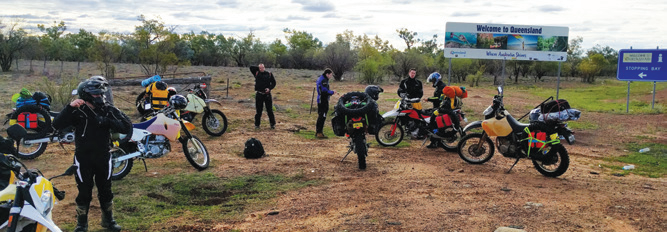 Heading north to Cunna-bloody-mulla.
Heading north to Cunna-bloody-mulla.
What channel to watch
It was now my son Henry’s turn to shine.
Henry had never ridden a motorcycle until he got his L plates three days before we left. They do a good job when they give you L plates these days, because Henry had led us all in speed and daring. He was soon able to show us what he was made of – as it turned out mostly blood, bone and gristle. He hit a channel at 100kph. The bike cartwheeled, the petrol tank cracked, the headlights and instruments disintegrated and a resulting spark caused an explosion.
In addition the subframe bent to the left by about 10cm. He was lucky enough to be thrown clear to land on something soft: his head.
Henry was doubly lucky. Not only was he thrown clear, but we also had mechanical geniuses in the form of Andrew, Shane, Chris and Matt who were able to sort through the pile of metal, bones, bolts and blood to rebuild something that almost looked like a DRZ – and something that looked a bit like Henry as well.
Maybe they made a few mistakes. Henry is now partial to a warm glass of 10W-50 on a cold day and the DRZ just asked me if it could borrow $10.
Top his credit, Henry stood up, dusted himself off, jumped on the wobbly DRZ and soldiered on.
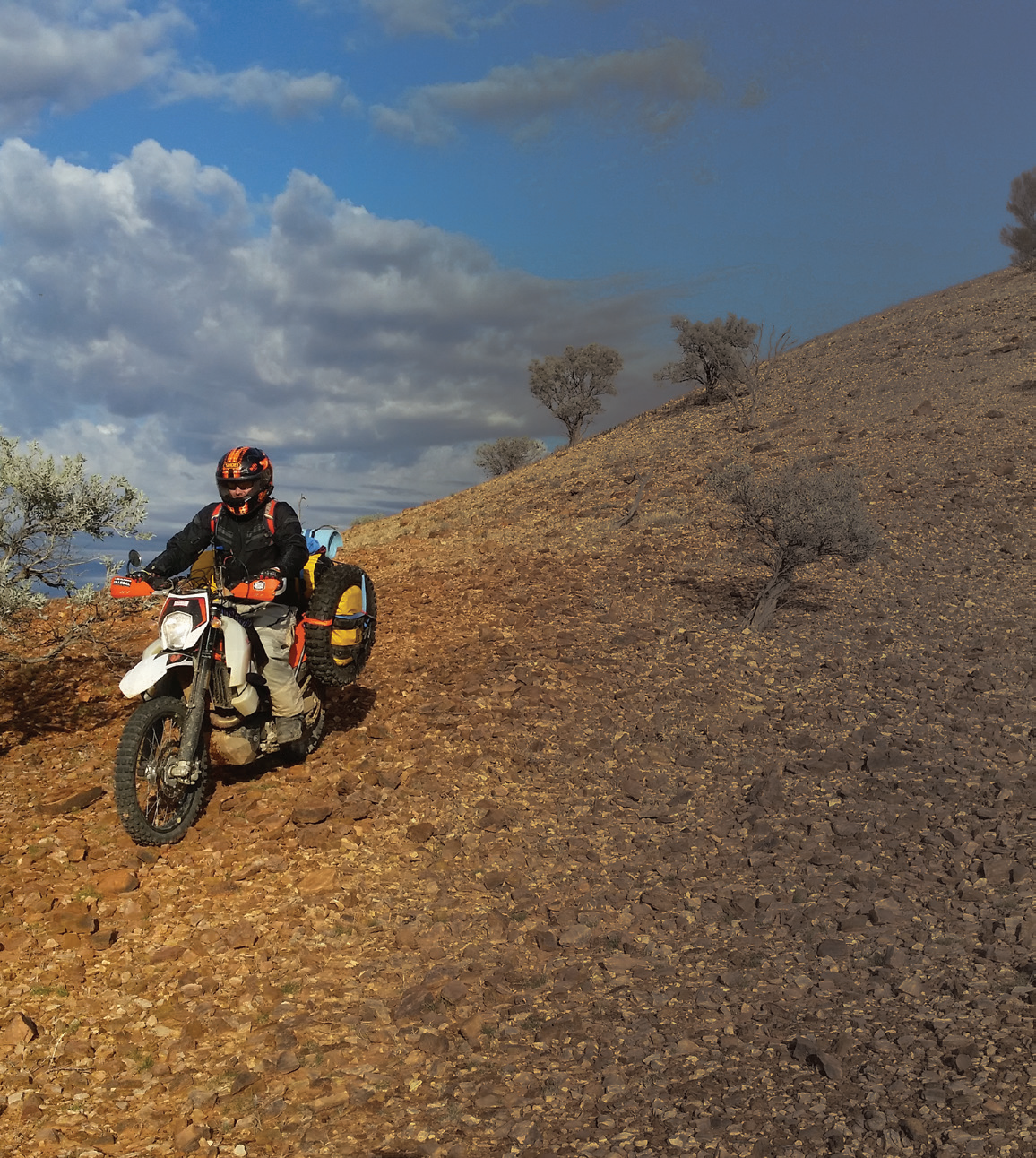 Some rocky sections made a muddy track look good.
Some rocky sections made a muddy track look good.
Diamantina Lakes
After some funny muddy river crossings we were getting near to our camp for the night, the Diamantina Lakes. It had been an eventful day in an area I’d wanted to see all my life. The rolling Mitchell-grass plains criss-crossed by the life-giving channels are unique and worth the trip if you ever get the chance. The SWMs ate it all up as if they’d been waiting for it.
Driving on sandy roads full of channels wears you out, but trying it in the dark was suicide, especially with no light on the DRZ.
As Henry and I trailed into camp late we were fully spent, battered and bruised by the pounding we’d taken.
The campsite was worth the effort except for one small problem. We’d chanced upon the mosquito State Of Origin training camp. Not for us your normal southern mozzie. Here we discovered the Jonathon Thurston, Cameron Smith and Sam Thaiaday mozzies. We tried our normal mozzie repellent, but just like a NSW State Of Origin defence it proved weak and gutless against Queensland might.
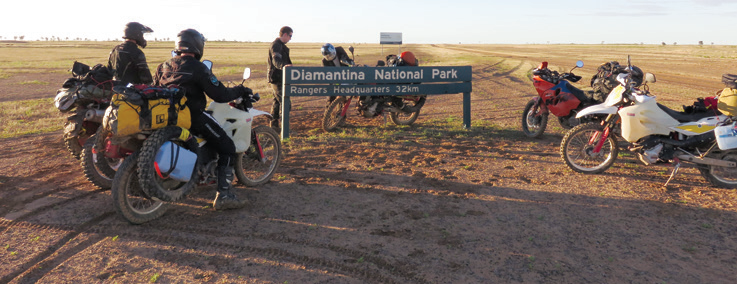 The Channel Country in the Diamantina National Park. No petrol or drinking water for 650km
The Channel Country in the Diamantina National Park. No petrol or drinking water for 650km
Boulia, Tobermorey and NT
We powered out of the beautiful Diamantina and on to Boulia.
Before we left we’d agreed on a detailed signalling system should things go wrong. About 30 minutes outside of Boulia I could see Jack on the DR pulled up and gesticulating. Carefully reading his signals as: “Dad, you arsehole, you’ve ruined my life. Pass the maramalade,” I knew he didn’t need my help. Waiting in Boulia for quite some time later it transpired Jack had run out of petrol. He was sorted by Chris and it was time for a new signalling system.
Tobermorey is a cattle station on the QLD/NT border. There’s a nice, grassy camping area, fuel, water and snacks. Once again we found ourselves in the middle of ’roo hour, but arrived safely. We’d heard bad reports about the Plenty/O’Donohue Highway that runs from Boulia to just north of Alice Springs, but in reality it was a very good dirt road with quite a few bitumen sections. Sure, some bits would rattle out your fillings, but these were few and far between. Maybe it had been graded after the recent rain.
We received advice not to go through to the Stuart Highway and onto Alice, but to take The Binns Track south off the Plenty Highway about 100km before the Stuart Highway. What a find! It wended its way through the hills and creeks then through the East MacDonnell Ranges towards Alice and was a fantastic ride. The only issue was a rock that caught in Matt’s chain, busting the joining link and snapping a tooth on the front sprocket (maybe a riveted link would have helped, but maybe not). Matt flew into action, punched out the broken link, tossed in a spare Shane just happened to have and, using Jack’s axe, had the bike back on the road in no time.
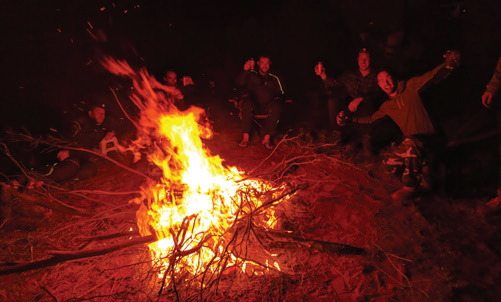 A happy crew.
A happy crew.
Weld one
We rolled into Ross River campground in ’roo hour yet again.
The people that run that place are the most obliging, kindly souls on earth. They fired up the closed kitchen, cooked us seven meals plus dessert, plied us with beer and had a slap-up breakfast ready for us in the morning. On top of this they gave Shane and Andrew the keys to the workshop where they were able to weld the panniers on the DR. The owners’ local knowledge was great too, and they set us up with some great tracks to finish the trip into Alice.
Alice Springs
Since we left Sydney we’d heard constant reports: “There’s been a stream of guys through here headed to Finke…”. We now could see and feel how true that was. In fact they weren’t just heading to the Finke race, they were heading to the main ’bike shop in Alice, the same as we did.
No matter how you ride to Alice you’ll end up there. The trip inevitably will have worn, shaken, tossed, vibrated, and smashed 30 per cent of the stuff on your bike and you’ll need to replace some of it to go any further. Given we still had to make it across the desert and Alice was the last opportunity for us to re-equip, there was even greater urgency.
The shelves of the bike shop were stripped bare as were the nearby Repco, auto and hardware stores. In spite of this we managed to build up a treasure chest of loot that included oil, chain lube, sprockets, chains, various M6, M8 and M10 nuts and bolts, epoxy for Henry’s tank and head-light and a clutch lever. The one thing we couldn’t get was a rear sprocket for the DRZ. That was a bit surprising and very troubling as it was now a buzz-saw blade and wouldn’t make it much further. I had packed a spare to change en route but left it in the Land Rover.
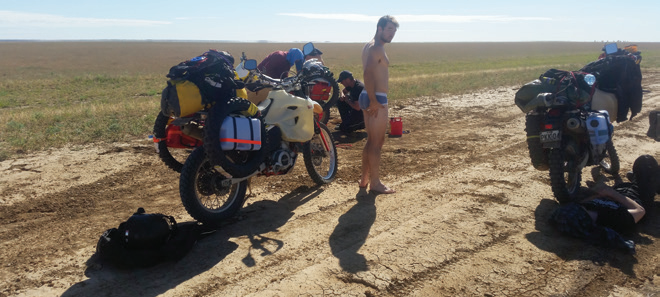 Is this what’s meant by ‘naked bike’?
Is this what’s meant by ‘naked bike’?
The race
While the Finke Desert Race was the nominal focus of the trip, the journey so far had been all-consuming and we hadn’t thought much about the race itself. But once you dip your toe into Alice at this time of year you get sucked in. The excitement and activity around town is incredible and it’s all focused on the Finke. We were soon wading in, and heading out to the track for scrutineering was like being a kid heading to the Easter Show.
A large chunk of the excitement and energy was coming from the Toby Price team.
We waited an hour in the signatures line but when we got there he didn’t want our signature, so that was a waste. But it was as great to see the Dakar bikes and his mount for Finke up close as it was to see Toby looking very relaxed and enjoying every minute.
After grilling the locals we found the thing to do was now head out to the actual track and find a place to camp. The Finke track from Alice to Finke is like two roads running in parallel a few hundred metres or so apart. The old rough track is what they race on, the other is a made dirt road.
In the dark, it’s the worst road on Earth as you inevitably pick out every rock, pothole, wheel rut, sand drift and corduroy patch there is. In the daylight you can pick a good path through it all and it’s quite good.
So the advice was to head down to about the 50km mark to avoid the crowds.
We made it to about the 30km mark before our bones said, ‘No more!’
As it turned out we found a great campsite a few metres away from the track and our neighbouring campers turned out to be fantastic people (as was everyone else we met on our trip).
They provided us with tools and equipment and took a great interest in our bikes – particularly the SWMs. One neighbour had towed down a wood-fired pizza van and kept us fed on the best pizzas we’d ever had, plus a slap-up bacon-and-eggs breakfast with coffee. Seven of us! And refused any payment.
We’d have loved to catch the race prologue but had to call a maintenance day.
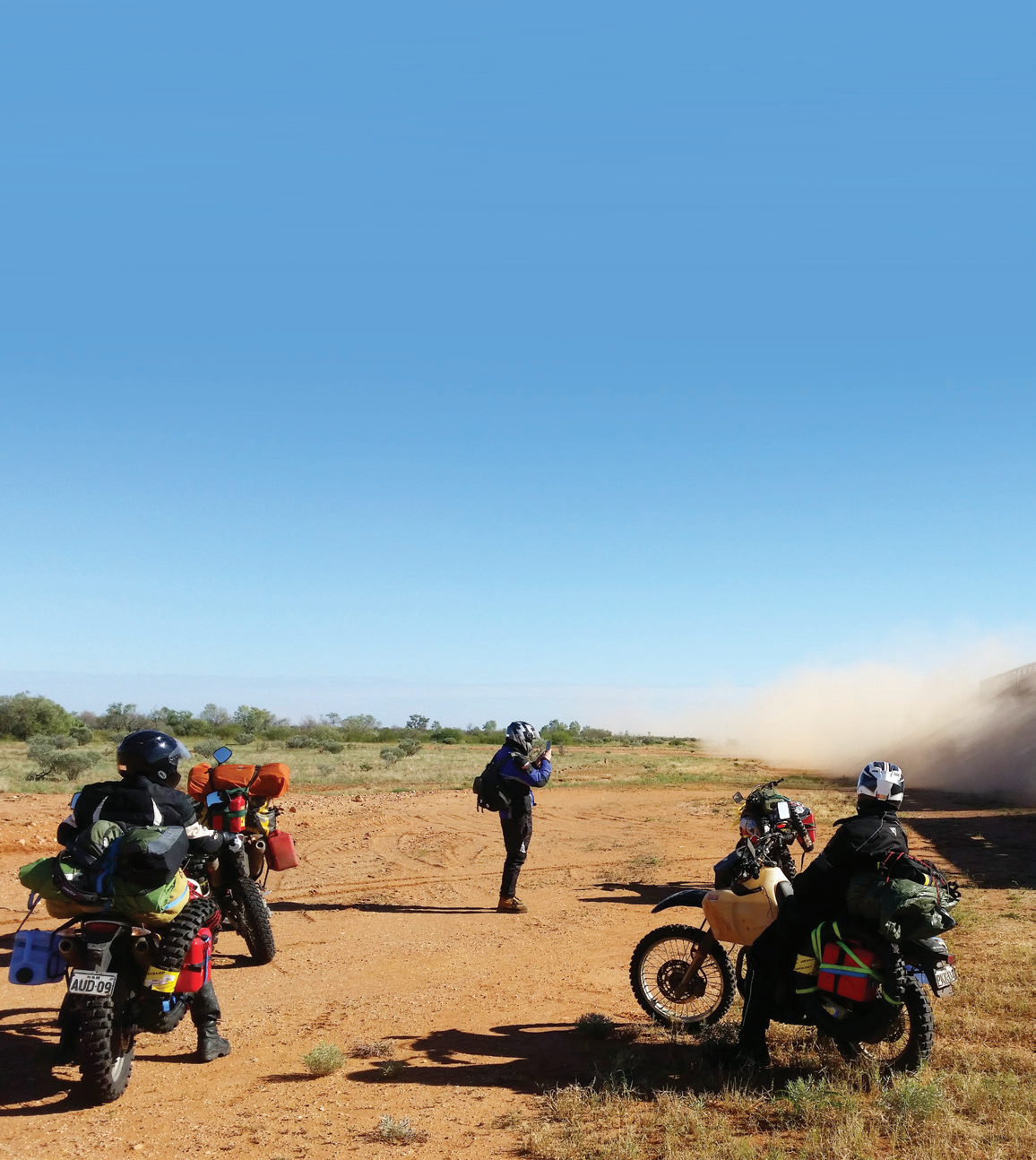 Road trains get right of way.
Road trains get right of way.
Race day
The first hint you get of the race is a helicopter screaming over the horizon heading towards you, but faster than any helicopter you’ve ever seen because it’s trying to keep up with the race leader doing around 200kph in a machine Mad Max could only dream of. For the few nanoseconds it takes for this tonne of metal, fuel and noise to go from one horizon to the other you stand transfixed as it affects you at the most basic level.
The cars are good, but bikes were what we were really there for, and the epitome of Finke bike racing is Toby Price in full flight, a helicopter trying to keep up. Toby seemed only loosely attached to his machine which seemed to have exemptions from the laws of physics as it floated about the track only occasionally kissing the earth to comply with race rules that forbid the use of aircraft.

The Rock
After three days of sleeping in the dirt, imbibing cartons of Fourex bitter, doing manly mechanical stuff and watching 200kph machines all day, someone rang the bell and each of the 100,000 or so spectators, like us, loaded up their vehicles and headed back into Alice.
We’d foreseen this and had sorted all our requirements the day before.
We scooted down the side of the traffic and just brushed the edge of Alice as we headed out to Hermannsberg to turn south down the Finke River en route to Uluru. Once more, through careful planning, we arrived in camp in the pitch black having negotiated some great, rocky, sandy, mud bogs in the process.
A roaring fire and some food and beer set us right for a good night’s sleep to wake up in one of the gorges of the spectacular Finke River.
We’d heard this trail was worth doing but were surprised at how beautiful the river actually was. There’d been some rain so the river had plenty of water and water crossings, but we understood there were a number of spots with permanent water.
That was surprising given the surrounding arid countryside.
The sandy trails at the southern end of the track were a real test for man and equipment and a taste on a minute scale of what we would be up against in The Simpson.
We pushed through to the bitumen and got to Uluru just before sunset.
Uluru
An Uluru sunset on a cloudless day is legendary, so we were lucky to see it go through its spectrum of colours.
The campground at Yulara was a welcome touch of relative luxury with grass and hot showers.
The next day we did the tourist trot, fuelled ourselves on bacon-and-egg sangas with coffee and were all packed up ready to take in the sites heading to Curtin Springs by nightfall. Before leaving Uluru we bumped into Magnus of Outback Adventure Treks. Magnus was running a trek across Australia with a group of guys on DRZ 400s. He proved a lifesaver by coughing up a new sprocket for Henry’s DRZ. In addition Magnus proved a wealth of information on tracks and bikes. What luck! We’d left the rain way back at Nyngan.
It’d always been close by, but kept just missing us. Doubling back to Curtin Springs gave it the chance to catch us and we were drenched as we pulled in to what would have to be the worst campground in the world – although it was free. It consisted of rock and mud. A nice steak dinner and a few beers made the ground a bit softer but we were glad to leave the next morning.
We were heading to Mt Dare and, rather than take the bitumen to Kulgera, we took the dirt road via Mulga Creek. We were worried this may have been a tough, slow option, particularly given the rain, but a few enquiries and we were happy it was worth the risk. It turned out to be a great stretch of dirt road. It was very scenic as it went down and around Mt Connor and then followed on the northern side of the Musgrave Ranges east until it hit the Stuart Highway just south of Kulgera.
We fuelled up in Kulgera and were ready for the final run to Mt Dare on the edge of The Simpson.
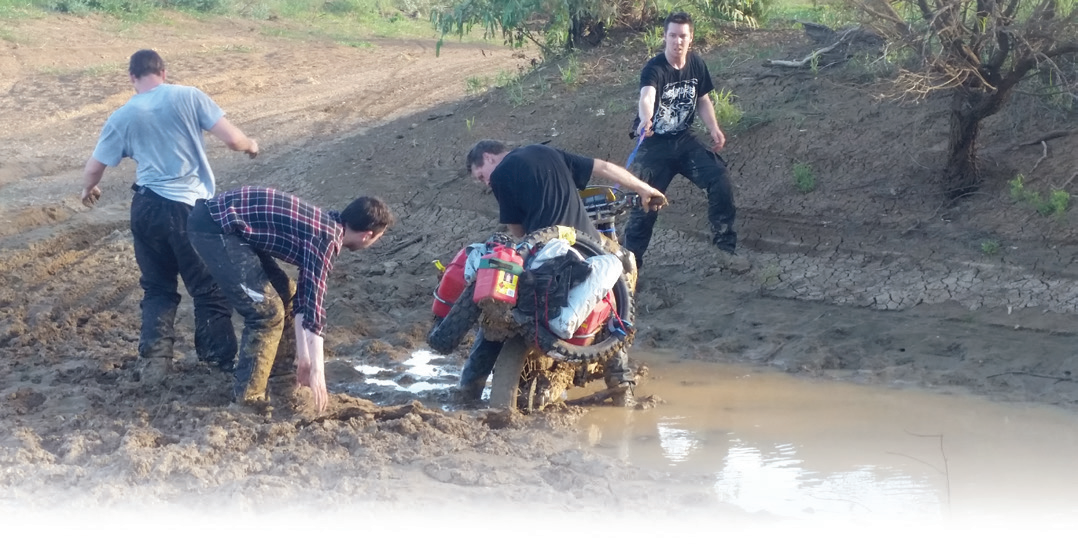
Bang on time
The dirt road from Kulgera to Mt Dare goes through the township of Arratula, which has also become known as Finke in recent times. About 12km outside of Arratula is the road that takes you 12km north to the geographic centre of Australia (and thus the universe). Overall, it’s beautiful country and a good road that becomes more interesting the further east you head.
With the recent rains the interesting bits came thick and fast, usually in the form of clay bog. If you looked at the interesting countryside you found yourself looking directly into an interesting pile of crap as you and bike parted company.
The landscape changed again as we neared Mt Dare. Sweeping green plains with a pungent perfume/onion smell presented themselves. The rain had given rise to a proliferation of this green stuff, transforming the usual black, stone, gibber plain completely.
As we rolled into Mt Dare with a sense of relief it dawned on us we were missing Andrew on his KTM. A mild panic started to creep in. The only sensible thing was to start drinking until we could think clearly what we needed to do.
After about an hour of the clear thinking it became even clearer we should keep drinking, then, just when we were about to order another round, Andrew appeared.
Looking a bit worse for wear, covered in mud and, as it was now his shout, with brilliant timing. Apparently, he’d visited the centre of the universe as per plan 11.2(c) and waited for us, subsequently drowned his KTM in mud and had to get a push start from some fellow travellers.
Springs water
Mt Dare is a fantastic place in so many ways.
The family that runs the place and their staff do such a good job of looking after every-one. Visitors can be divided into two camps: those that have just crossed the desert and those that are about to. There’s a great camaraderie as stories and information are exchanged in an atmosphere of good food and drink.
The next morning we hopped into a half-day of mechanical work, changing the remaining tyres and sprockets,tightening bolts, filling petrol and water cans (tip certainly fill your water here, but there’s probably better water at Dalhousie Springs if you’re lucky).
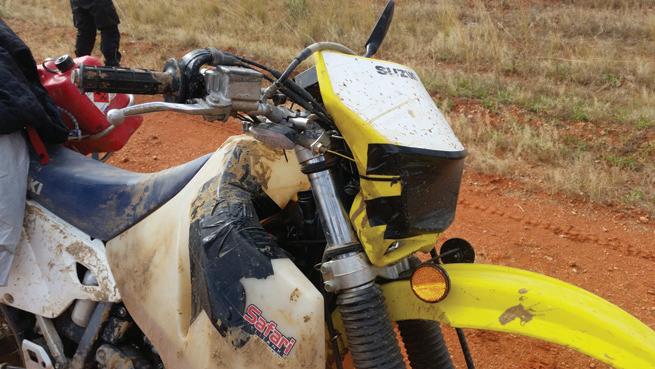 The bike cartwheeled, the petrol tank cracked, the headlights and instruments disintegrated and a resulting spark causing an explosion.
The bike cartwheeled, the petrol tank cracked, the headlights and instruments disintegrated and a resulting spark causing an explosion.
The Desert beckons
We were now ready for the hardest part of the trip: over 500km of desert, including 1100 sand dunes. Some of us had done it before and knew what lay ahead.
The fact the Finke crowd had already been back and forth both ways meant the tracks had been cut to shreds with wheel ruts you could lose a whole car in – or so went the stories.
This was really what our trip was about: proffering our bikes and our carcasses to the desert to receive judgement.
t was a beautiful sunny day with nice crisp air – great for riding. We got to Dalhousie Springs without any trouble and enjoyed the soothing hot springwater bath, a slightly unreal experience for a desert.
The plan was to push on to Purni Bore for the night. It turned out to be a most enjoyable ride across very solid sand/clay roads – nothing like we remembered.
We arrived at Purni bore just before dark and set up camp on the spacious mud flat.
Matt spent an enjoyable night re-seating his petrol pump which he’d initially installed in a bit of a rush and pretty well effed it.
After several tries he cracked it and went to bed a happy man.
Henry, at the same time, was re-attaching his pannier rack to the DRZ.
These pannier racks had already done one Simpson crossing and a Cape York trip.
The design was groundbreaking and possibly bike-breaking. If you can imagine two steel cradles joined in the middle with a thin, flat piece of steel with all the stiffness of a rubber band, then you’ve got it. The amount of movement in these things was terrifying, but somehow they continued to work…although they live on a diet of M6 nuts and bolts.
Running hot and cold
One of the attractions of Purni Bore is the hot showers. The way to get the hot shower to work is as follows:
• Announce there are hot showers and you are going to have one
• Loiter for a few moments, then watch as at least two other people race across and beat you to the shower
• Wait until they’ve each stopped screaming about the cold water and cursing you. The shower is now ready, but hang out for another minute or so to be sure the water has completely made it across from the hot bore to the cold shower.
The real thing
We knew we’d got off lightly so far in terms of track, so with a steely resolve we headed east to soak up the increasingly bad terrain.
After a few initial sand-dune crashes my worst fears were confirmed: Hell on Earth awaited…except it didn’t.
Each kilometre was easier than the last.
The wet weather and heavy traffic had turned most of the track into a kind of dark, desert highway.
We held a great pace and decided to slow up to enjoy the scenery. We’d planned a route that would have taken us to visit the Lone Gum Tree. It was about 50km longer than the French Line, but most of it was straight up a mud flat between the dunes and was reasonably easy going. We had 40 litres of petrol each so should’ve had just enough to take this on.
Speaking with some 4WD guys who’d just visited the Lone Gum Tree, we found the route we’d planned was blocked by water and needed a 150km detour which we couldn’t afford petrol-wise. No problem. We stuck with the French Line.
Hangin’ in
The landscape in the Simpson Desert is incredible. Sure there’s a common theme to it all, but the variations and combinations of colours, vegetation, salt flats, dunes, mud flats, sand hills and sand flats meant every part is a winner and you really want to stop on every dune and soak it all in.
The last night we stopped more or less where we’d planned, just short of Eyre Creek, due to Chris getting a flat.
The flat seemed to have been caused by dodgy installation. We recalled this was the tyre fitted at Mt Dare at about midnight after a night of beer and wondered if that contributed.
Our plan was to have an easy last day and enjoy Big Red (the massive final dune 30km west of Birdsville), then have time to clean up in Birdsville.
It was a very enjoyable day as time seemed to slip by. We cruised between the big sand dunes then saw Big Red looking majestic like a massive, red, sand wave ready to break. There were a number of tracks up the western side facing us.
The direct path looked terrifying from below as it had a steep, sharp lip at the top.
This was the showdown.
We chose a representative from each of the teams to take on the steep approach: Matt on SWM, Andrew on KTM and Jack on Suzuki.
Jack fired up Acker-Dacker on his boom-box and set up about a two-kilometre run up. He hit Big Red in top gear and the combination of weight, crap suspension and high gearing meant he got within a whisker of the top. When the dust settled we could see Jack hanging from the lip by a fingernail.
Next Matt fired up his SWM near the base and masterfully picked out a route among the wheel ruts so he could finish off with a burst of power and sail over the lip to make it look easy. When Andrew let slip the KTM it didn’t disappoint either.
The rest of us took the scenic route up the right-hand side, still a challenge due to the heavy traffic and wheel ruts, but less steep than the direct route.
The view from on top was great and I relaxed while some of the others had fun going up and down until they were completely shagged.

Hot and wet
The road into Birdsville from Big Red was nothing short of a dirt superhighway. We did the 30km with ease and headed to the Birdsville bakery where they have a great selection of pies – including camel and kangaroo – and other food and drink.
Next was a stop at the Birdsville bore hose, a facility just around the corner from the pub, where you can hose down your vehicle with hot borewater for free. The salty mud from the mud-flat crossings dries and leaves a ceramic layer 10cm thick on most of the lower parts of the bikes. The extra weight and thermal problems meant we were glad to get rid of this stuff and a hot hose was the only way.
Get outta town
With stomachs full, bikes clean and tents up, we were off to do some quick laundry before hitting the pub for afternoon tea. The ride across the desert was very intoxicating, but nowhere near as intoxicating as a 10-hour session at the pub followed by a rum party back at the camp.
Thank goodness Shane and I knew when we’d had enough and drank for only a few more hours before staggering back toour
tents. The younger guys left their staggering for much later and added in a bit of brawling among themselves, marauding, yelling, howling (it was a full moon) and petrol explosions.
When the police turned up in the morning I told the boys to act dumb (they found this very easy) and let me do the talking. At first the sergeant was going to run us out of town, but after I explained the circumstances he was more inclined toward a lynching. When the angry mob turned up we thought it diplomatic to pack and leave. We might have used the line, “We’ve been thrown out of better places than this,” except that Birdsville is a fantastic place and it is to our shame we haven’t been thrown out of anywhere better.
A great trip
Our plan was to head south to Innamincka and then Cameron Corner.
After ringing through we confirmed all roads to Innamincka were closed by the recent rains and so were the top parts of the Strzelecki and Birdsville Tracks. The only way to Sydney now was back to Windorah, east through to Charleville and down through St George and Moree.
After a couple of days of hard slog we ended up at the fantastic Nindigully Pub, 45km south of St George and, as luck would have it, just in time for State Of Origin 2. We’d taken the scenic route from Charleville – dirt farm roads with flooded river crossings – so we were ready to dry out by the fire, relax with a XXXX Bitter and watch our champions thrash NSW yet again.
We were almost home. With the wisdom of youth, the five lads decided to extract some more adventure by going via the freezing and flooded New England Highway and through the ice and snow of Barrington Tops. With the speed of old age, Shane and I decided we would make a final dash for home via the wet, but less flooded, cold but less frozen, Newell Highway.
What a great trip – a fantastic 7500 km of unbelievable country, people, tracks and challenges. All the bikes held up well, especially the SWMs, which were a pleasure to ride on any surface and could handle the toughest stuff with ease. For the type of rides I like, long-distance with plenty of rough stuff, I couldn’t think of a better fit than my new SWM.

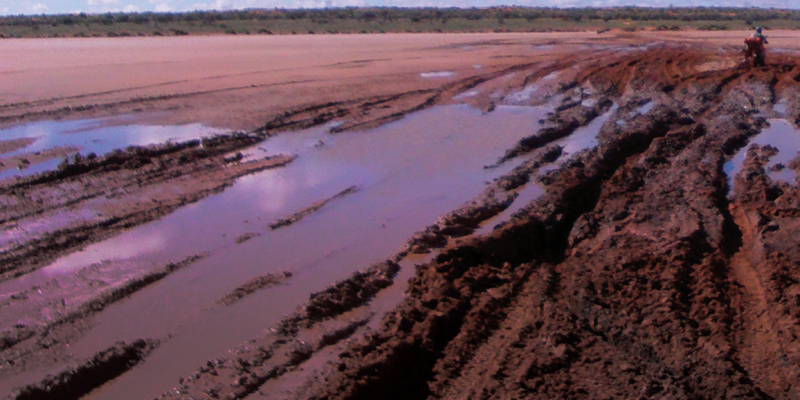

















Comments